asp.net,我想做一个企业网址,别人提供了HTML页面,但是我怎么把数据绑定在html里面把数据展示给别人看
Posted
tags:
篇首语:本文由小常识网(cha138.com)小编为大家整理,主要介绍了asp.net,我想做一个企业网址,别人提供了HTML页面,但是我怎么把数据绑定在html里面把数据展示给别人看相关的知识,希望对你有一定的参考价值。
先去学一下asp.net自己弄。这是你需要了解的整个过程(可以按照该过程按照需要去学习asp.net)
1.页面发出data请求->2.后台接受到请求到DB取data到后台->把data通过各种形式传到前台->通过前台的脚本语言处理显示到html页面
主要学。
1.从数据库取数据。
这一块基本上方法都差不多就看你怎么取。
学一下sql语句
2.从后台把数据传到前台。
3.前台显示 (涉及到html的布局[div+css之类的] 和网页的脚本语言[比如javascript 或者用一些成型的库如jquery等。])
4.如果还涉及到数据交互的话可能会用到ajax(当然选择get post之类的那些都不提在asp.net学习中肯定会学的。ajax不一定)
或者是花钱找个会的人给他点银子然后让他帮你搞定。 参考技术A 这个问题。你能这么问我敢说你对.net一点都不熟悉。你还是找别人帮你做。或者直接展示静态页面。 参考技术B 把页面切下来 在aspx 里重新拼 之后需要数据 的地方重数据库读就行了 参考技术C 用数据控件,绑定数据库
ASP.NET Identity登入技术应用
情景
ASP.NET Identity是微软所贡献的开源项目,用来提供ASP.NET的验证、授权等等机制。在ASP.NET Identity里除了提供最基础的:用户注册、密码重设、密码验证等等基础功能之外,也提供了进阶的:Cookie登入、Facebook登入、Google登入等等进阶功能。套用这些功能模块,让开发人员可以快速的在ASP.NET站台上,提供验证、授权等等机制。
但是在企业中,开发人员常常会遇到一种开发情景就是:企业里已经有一套既有身分系统,这个系统提供了:用户注册、密码重设、密码验证等等功能,新开发的ASP.NET站台,必须要串接既有身分系统来提供验证、授权等等机制。这个既有身分系统,可能是大卖场会员管理系统、也可能是银行帐户管理系统,它们的注册审核机制有一套严谨并且固定的流程。
在这样的开发情景中,开发人员可能会选择透过程序接口、OAuth机制等等方式,将既有身分系统整合成为ASP.NET Identity的验证提供者。这样两个系统之间的整合,除了有一定的高技术门坎之外。在整合之后,两个系统之间互相重迭的功能模块,操作流程的冲突该如何处理,也是一个需要额外考虑的复杂问题。
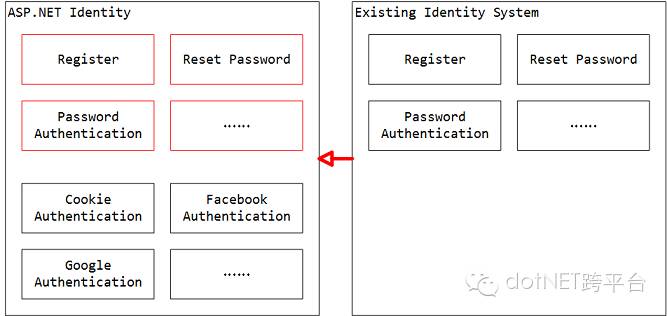
一个好消息是,ASP.NET Identity拥有高度模块化的软件架构。在ASP.NET Identity中,将Cookie登入、Facebook登入、Google登入等等功能模块,切割为独立的ASP.NET Security套件。开发人员完全可以直接套用ASP.NET Security套件,快速整合既有的身分系统,就可以提供ASP.NET站台所需的验证、授权等等机制。本篇文章介绍如何套用ASP.NET Security来整合既有身分系统,用以提供ASP.NET站台所需的验证、授权等等机制。主要为自己留个纪录,也希望能帮助到有需要的开发人员。

范例
范例程序代码:
开发
开始套用ASP.NET Security之前,先建立一个空白的MVC项目,来提供一个新的ASP.NET站台。并且变更预设的Web服务器URL为:「http://localhost:41532/」,方便完成后续的开发步骤。
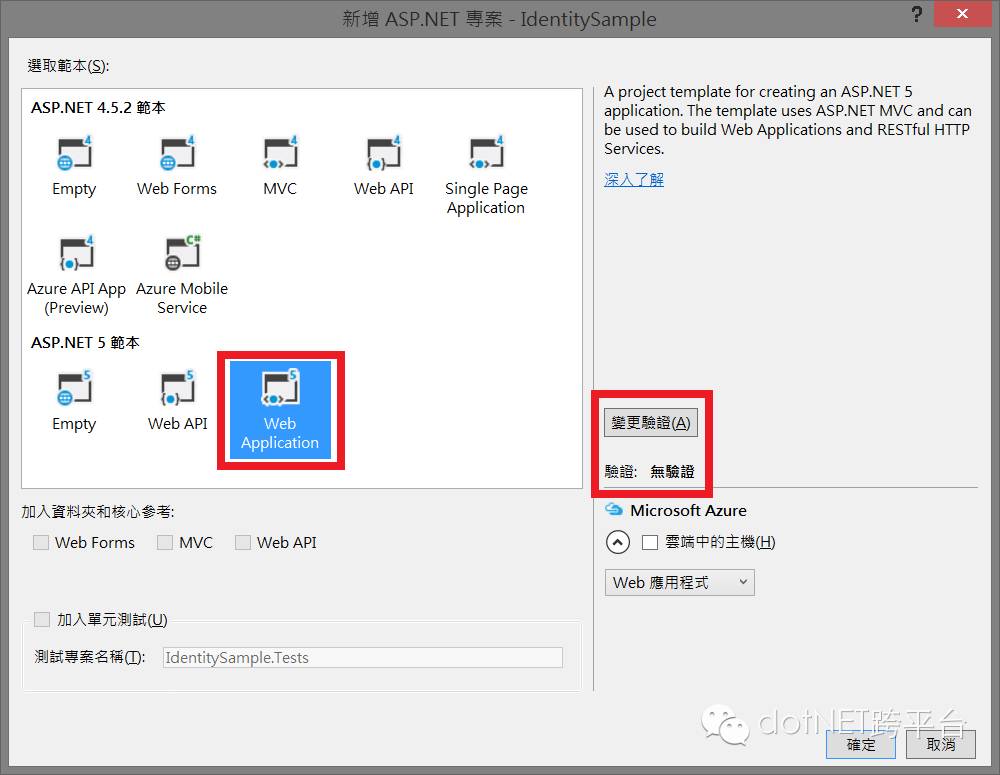
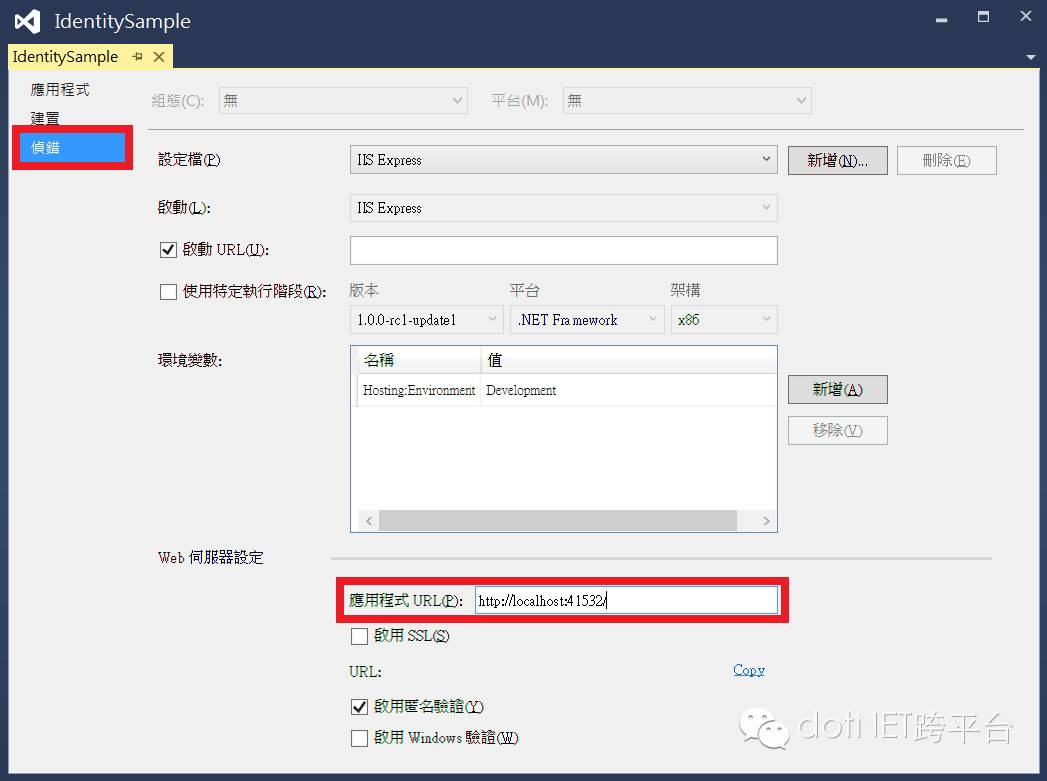
再来在MVC项目里加入三个ASP.NET Security的NuGet套件参考:Microsoft.AspNet.Authentication、Microsoft.AspNet.Authentication.Cookies、Microsoft.AspNet.Authentication.Facebook。
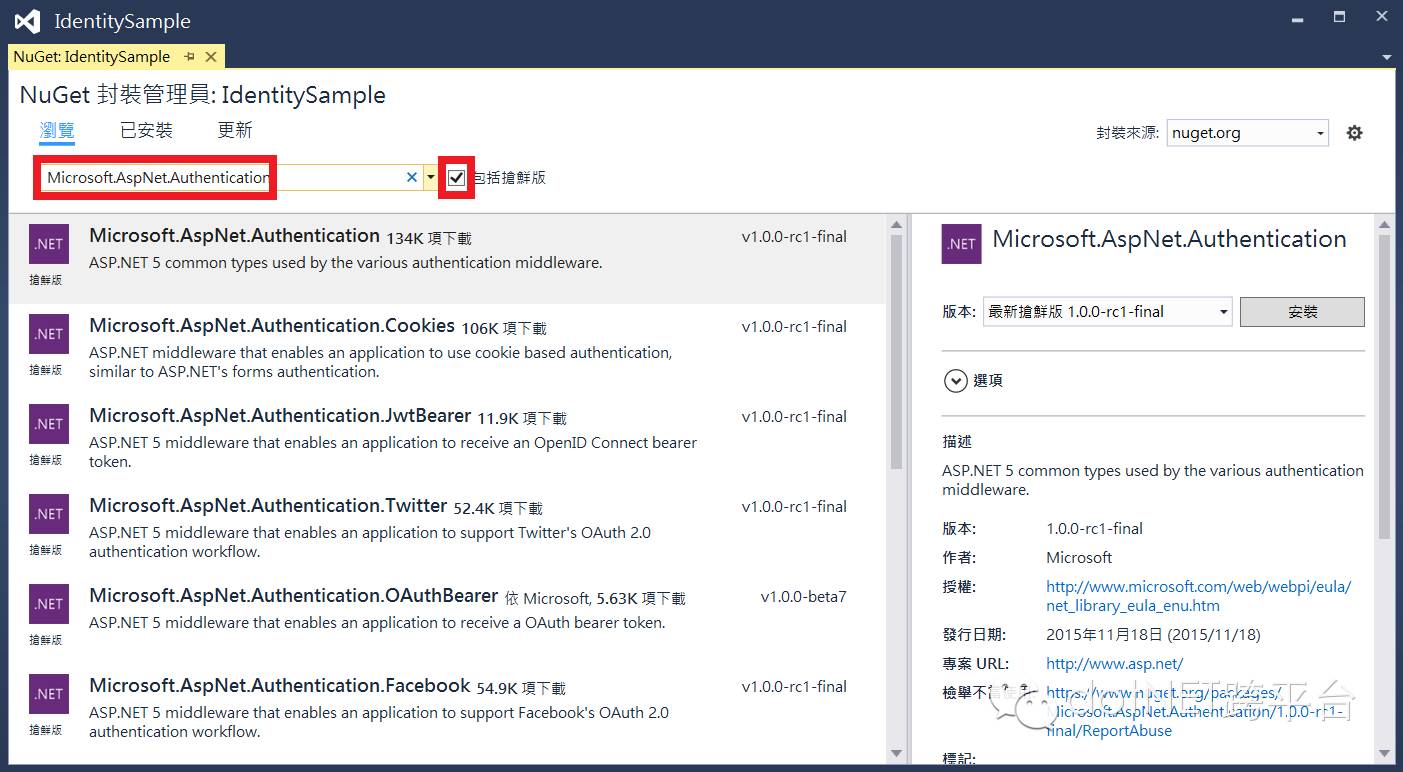
接着建立AccountController以及相关的View,用以提供登入页面,让使用者可以选择使用哪种模式登入系统。
public class AccountController : Controller
{
// Methods
public IActionResult Login(string returnUrl = null)
{
// ViewData
this.ViewData["ReturnUrl"] = returnUrl;
// Return
return View();
}
}再来在MVC项目内加入下列程序代码,用以挂载与设定后续要使用的两个CookieAuthenticationMiddleware。(关于程序代码的相关背景知识,请参阅技术剖析说明:)
public class Startup
{
public void ConfigureServices(IServiceCollection services)
{
// Authentication
services.AddAuthentication(options =>
{
options.SignInScheme = IdentityOptions.Current.ExternalCookieAuthenticationScheme;
});
}
public void Configure(IApplicationBuilder app, IHostingEnvironment env, ILoggerFactory loggerFactory)
{
// Authentication
app.UseCookieAuthentication(options =>
{
options.AuthenticationScheme = IdentityOptions.Current.ApplicationCookieAuthenticationScheme;
options.AutomaticAuthenticate = true;
options.AutomaticChallenge = true;
options.LoginPath = new PathString("/Account/login");
});
app.UseCookieAuthentication(options =>
{
options.AuthenticationScheme = IdentityOptions.Current.ExternalCookieAuthenticationScheme;
options.AutomaticAuthenticate = false;
options.AutomaticChallenge = false;
options.LoginPath = null;
});
}
}最后在MVC项目内,建立ExistingIdentitySystem这个类别用来仿真既有身分系统。为了方便理解系统,ExistingIdentitySystem里的PasswordSignIn(密码登入)、ExternalSignIn(第三方登入ex:FB登入)等方法都直接回传成功讯息,而GetUserById(取得使用者)这个方法则是直接回传固定的用户信息。(在正式环境开发时,上述方法可以实作为透过WebAPI、或是直接连通数据库等等方式,与既有身分系统取得相关信息。)
public class ExistingIdentitySystem
{
// Methods
public ExistingUser GetUserById(string userId)
{
// Result
var user = new ExistingUser();
user.Id = "Clark.Lab@hotmail.com";
user.Name = "Clark";
user.Birthday = DateTime.Now;
// Return
return user;
}
public bool PasswordSignIn(string userId, string password)
{
// Return
return true;
}
public bool ExternalSignIn(string userId, string externalProvider)
{
switch (externalProvider)
{
case "Facebook": return true;
default:
return true;
}
}
}
public class ExistingUser
{
// Properties
public string Id { get; set; }
public string Name { get; set; }
public DateTime Birthday { get; set; }
}开发 - Facebook Authentication
完成上述步骤后,接着着手开发Facebook验证。首先开发人员可以到,注册一个新的APP账号。(测试用的Site URL为先前步骤定义的:「http://localhost:41532/」)
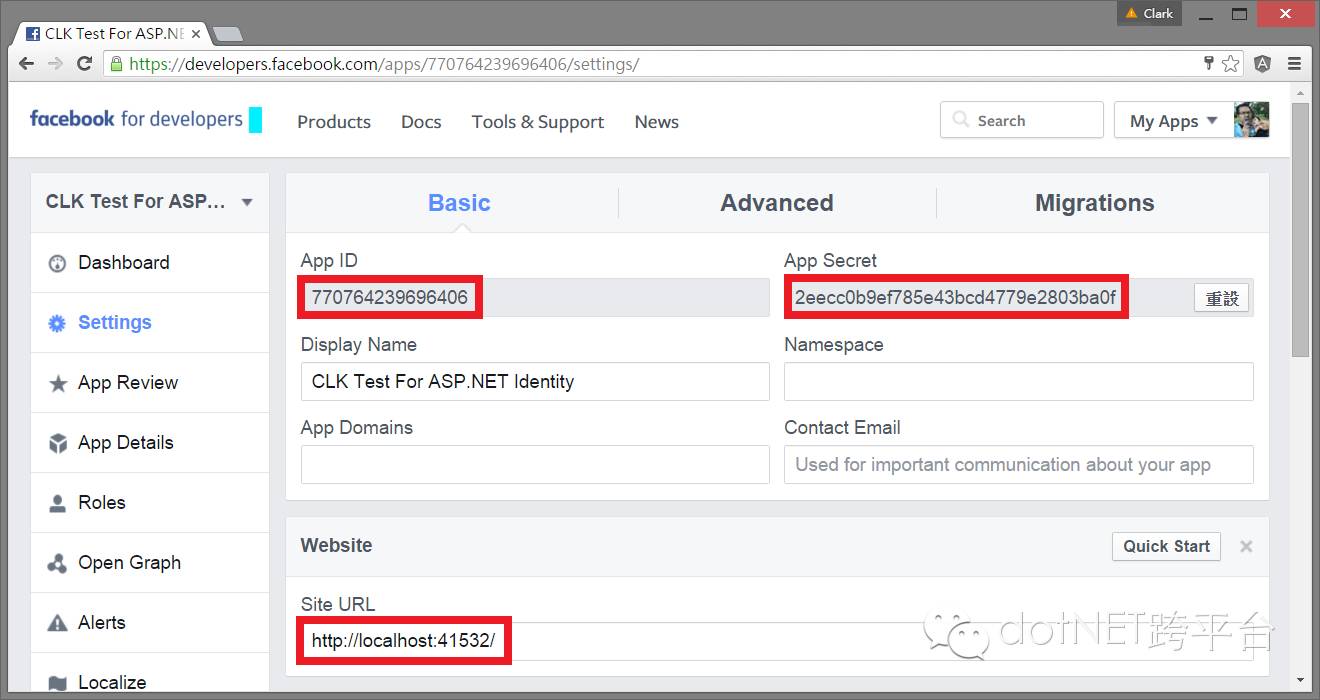
接着在MVC项目内加入下列程序代码,用以挂载与设定FacebookAuthenticationMiddleware。在这其中AppId、AppSecret是Facebook开发者中心提供的APP账号数据,而Scope、UserInformationEndpoint两个参数则是定义要额外取得用户的E-Mail信息。
public class Startup
{
public void Configure(IApplicationBuilder app, IHostingEnvironment env, ILoggerFactory loggerFactory)
{
// Authentication
app.UseFacebookAuthentication(options =>
{
options.AppId = "770764239696406";
options.AppSecret = "2eecc0b9ef785e43bcd4779e2803ba0f";
options.Scope.Add("email");
options.UserInformationEndpoint = "https://graph.facebook.com/v2.5/me?fields=id,name,email";
});
}
}再来打开AccountController加入下列程序代码以及对应的View,用以提供ASP.NET站台处理Facebook这类的第三方登入(ExternalLogin)。在这其中,ExternalLogin用来发起一个验证挑战(Challenge),系统会依照externalProvider参数,来决定是要向Facebook或是其他第三方系统做验证。
当用户通过验证后,系统会调用ExternalLoginCallback来处理验证结果。在ExternalLoginCallback里会取得验证结果中FBUser的UserId,用来与ExistingIdentitySystem做验证。如果验证通过,会接着从ExistingIdentitySystem取得对应的ExistingUser、再转换为APPUser来真正登入系统。(关于程序代码的相关背景知识,请参阅技术剖析说明:)
public class AccountController : Controller
{
public IActionResult ExternalLogin(string externalProvider, string returnUrl = null)
{
// AuthenticationProperties
var authenticationProperties = new AuthenticationProperties();
authenticationProperties.Items.Add("ExternalProvider", externalProvider);
authenticationProperties.RedirectUri = Url.Action("ExternalLoginCallback", "Account", new { ReturnUrl = returnUrl });
// Return
return new ChallengeResult(externalProvider, authenticationProperties);
}
public async Task<IActionResult> ExternalLoginCallback(string returnUrl = null)
{
// AuthenticateContext
var authenticateContext = new AuthenticateContext(IdentityOptions.Current.ExternalCookieAuthenticationScheme);
await this.HttpContext.Authentication.AuthenticateAsync(authenticateContext);
// AuthenticateInfo
string userId = authenticateContext.Principal.FindFirst(ClaimTypes.Email).Value;
string externalProvider = authenticateContext.Properties["ExternalProvider"] as string;
// Login
var existingIdentitySystem = new ExistingIdentitySystem();
if (existingIdentitySystem.ExternalSignIn(userId, externalProvider) == false)
{
throw new InvalidOperationException();
}
// ExistingUser
var existingUser = existingIdentitySystem.GetUserById(userId);
if (existingUser == null) throw new InvalidOperationException();
// ApplicationUser
var applicationIdentity = new ClaimsIdentity(IdentityOptions.Current.ApplicationCookieAuthenticationScheme, ClaimTypes.Name, ClaimTypes.Role);
applicationIdentity.AddClaim(new Claim(ClaimTypes.NameIdentifier, existingUser.Id));
applicationIdentity.AddClaim(new Claim(ClaimTypes.Name, existingUser.Name));
var applicationUser = new ClaimsPrincipal(applicationIdentity);
// Cookie
await this.HttpContext.Authentication.SignInAsync(IdentityOptions.Current.ApplicationCookieAuthenticationScheme, applicationUser);
await this.HttpContext.Authentication.SignOutAsync(IdentityOptions.Current.ExternalCookieAuthenticationScheme);
// Return
return Redirect(returnUrl);
}
}开发 - Password Authentication
完成上述步骤后,接着着手开发Password验证。打开AccountController加入下列程序代码以及对应的View,用以提供ASP.NET站台处理Password验证。在这其中,PasswordLogin会接收用户输入的账号密码,用来与ExistingIdentitySystem做验证。如果验证通过,会接着从ExistingIdentitySystem取得ExistingUser、再转换为APPUser来真正登入系统。(关于程序代码的相关背景知识,请参阅技术剖析说明:)
public class AccountController : Controller
{
public async Task<IActionResult> PasswordLogin(string userId, string password, string returnUrl = null)
{
// Login
var existingIdentitySystem = new ExistingIdentitySystem();
if (existingIdentitySystem.PasswordSignIn(userId, password) == false)
{
throw new InvalidOperationException();
}
// ExistingUser
var existingUser = existingIdentitySystem.GetUserById(userId);
if (existingUser == null) throw new InvalidOperationException();
// ApplicationUser
var applicationIdentity = new ClaimsIdentity(IdentityOptions.Current.ApplicationCookieAuthenticationScheme, ClaimTypes.Name, ClaimTypes.Role);
applicationIdentity.AddClaim(new Claim(ClaimTypes.NameIdentifier, existingUser.Id));
applicationIdentity.AddClaim(new Claim(ClaimTypes.Name, existingUser.Name));
var applicationUser = new ClaimsPrincipal(applicationIdentity);
// Cookie
await this.HttpContext.Authentication.SignInAsync(IdentityOptions.Current.ApplicationCookieAuthenticationScheme, applicationUser);
await this.HttpContext.Authentication.SignOutAsync(IdentityOptions.Current.ExternalCookieAuthenticationScheme);
// Return
return Redirect(returnUrl);
}
}使用
完成开发步骤后,当系统执行到打上[Authorize]标签的Controller或是Action时,就会跳转到Login页面。
public class HomeController : Controller
{
[Authorize]
public IActionResult Contact()
{
ViewData["Message"] = "Hello " + User.Identity.Name + "!";
return View();
}
}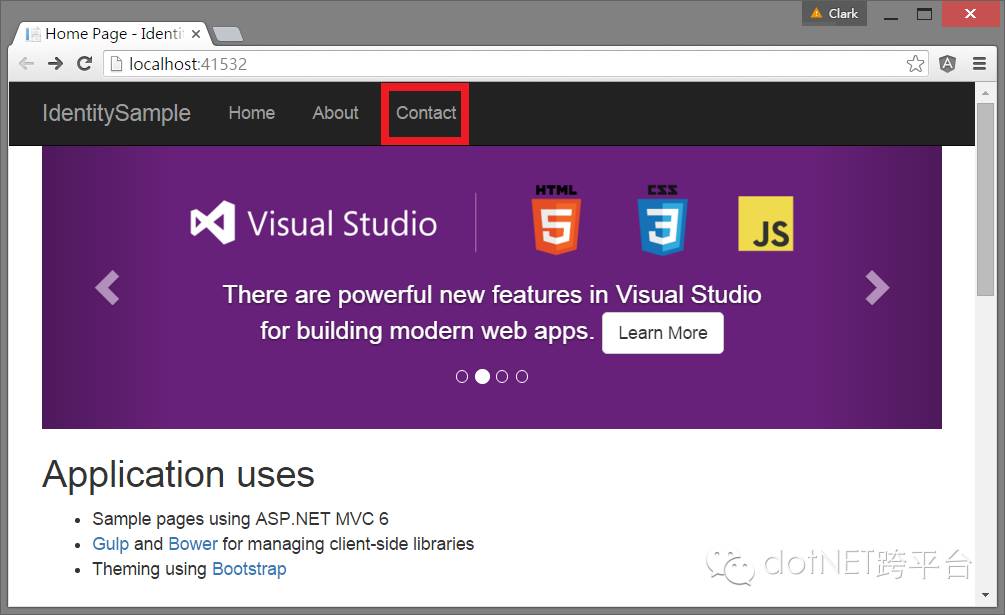

使用 - Facebook Authentication
在Login页面,当使用者选择使用Facebook验证,系统会跳转到Facebook页面进行验证与授权。完成验证授权的相关步骤后,使用者就可以进入被打上[Authorize]标签的Controller或是Action。
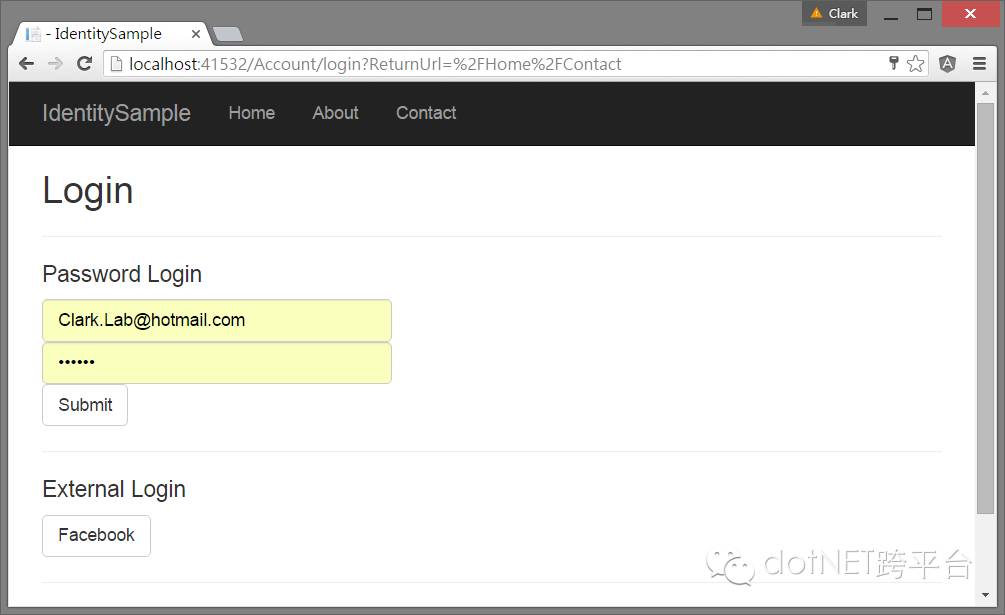


使用 - Password Authentication
在Login页面,当使用者选择使用Password验证,系统会使用Login页面上输入的账号密码来进行验证与授权。完成验证授权的相关步骤后,使用者就可以进入被打上[Authorize]标签的Controller或是Action。
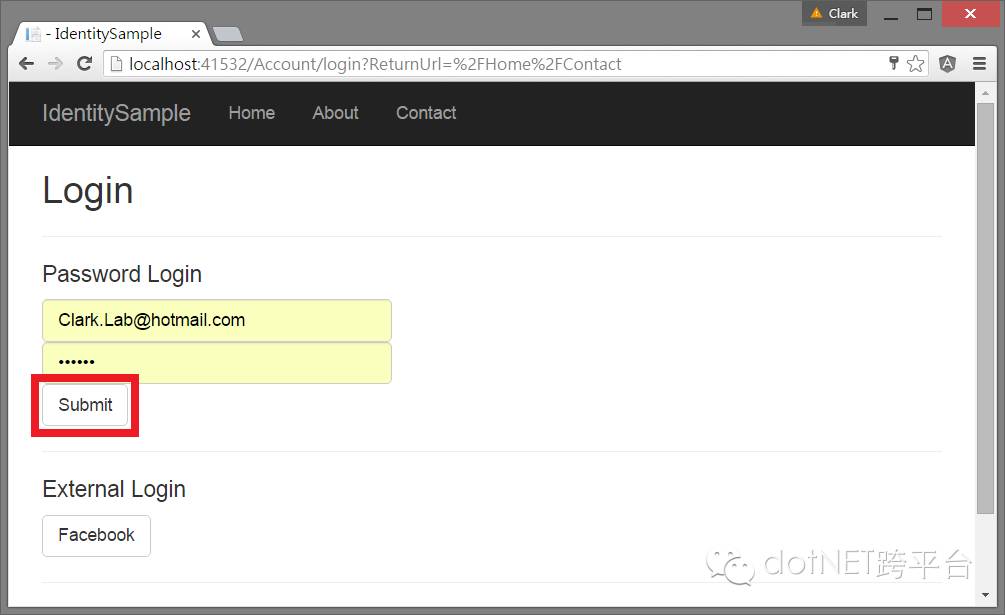
范例
范例程序代码:
以上是关于asp.net,我想做一个企业网址,别人提供了HTML页面,但是我怎么把数据绑定在html里面把数据展示给别人看的主要内容,如果未能解决你的问题,请参考以下文章